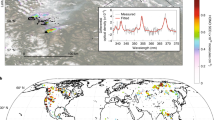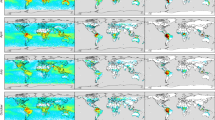Abstract
The hydroxyl radical is a key oxidant in the Earth’s atmosphere. This short-lived highly reactive molecule plays an important role in the degradation of volatile organic compounds, leading to the production of ozone and the formation and growth of aerosol particles1,2,3. In this way, hydroxyl radicals influence air quality and regional climate. Measurements over tropical forests suggest that hydroxyl radicals are recycled following reaction with the volatile organic compound isoprene4,5, but the chemistry underpinning this observation is uncertain. Here, we propose a detailed chemical mechanism for the oxidation of isoprene by hydroxyl radicals. The photo-oxidation of unsaturated hydroperoxy-aldehydes—a product of isoprene oxidation—is a central part of the mechanism; their photolysis initiates a hydroxyl radical production cascade that is limited by the reaction of hydroperoxy-aldehydes with the hydroxyl radical itself. We incorporate this mechanism into a global atmospheric chemistry model and find that measurements of hydroxyl radical concentrations over a pristine region of the Amazon, and in moderately polluted conditions, are captured well. On the basis of this agreement, we suggest that isoprene oxidation can buffer hydroxyl radical concentrations, by serving as both a sink and source for these radicals.
This is a preview of subscription content, access via your institution
Access options
Subscribe to this journal
Receive 12 print issues and online access
$259.00 per year
only $21.58 per issue
Buy this article
- Purchase on Springer Link
- Instant access to full article PDF
Prices may be subject to local taxes which are calculated during checkout




Similar content being viewed by others
Change history
28 February 2012
This Letter was published online and in print with the author M. G. Lawrence being incorrectly affiliated to the Cyprus Institute. This has been corrected in the PDF and HTML versions of this Letter.
References
Ganzeveld, L. & Lelieveld, J. Impact of Amazonian deforestation on atmospheric chemistry. Geophys. Res. Lett. L06105 (2004).
Arneth, A. et al. Terrestrial biogeochemical feedbacks in the climate system. Nature Geosci. 3, 525–532 (2010).
Pöschl, U. et al. Rainforest aerosols as biogenic nuclei of clouds and precipitation in the Amazon. Science 329, 1513–1516 (2010).
Lelieveld, J. et al. Atmospheric oxidation capacity sustained by a tropical forest. Nature 452, 737–740 (2008).
Butler, T. M. et al. Improved simulation of isoprene oxidation chemistry with the ECHAM5/MESSy chemistry-climate model: Lessons from the GABRIEL airborne field campaign. Atmos. Chem. Phys. 8, 4529–4546 (2008).
Lawrence, M. G., Jöckel, P. & von Kuhlmann, R. What does the global mean OH concentration tell us? Atmos. Chem. Phys. 1, 37–49 (2001).
Levy, H. I. Normal atmosphere: Large radical and formaldehyde concentrations predicted. Science 141–143 (1971).
Guenther, A. et al. A global model of natural volatile organic compound emissions. J. Geophys. Res. 100, 8873–8892 (1995).
Dillon, T. J. & Crowley, J. N. Direct detection of OH formation in the reactions of HO2 with CH3C(O)O2 and other substituted peroxy radicals. Atmos. Chem. Phys. 8, 4877–4889 (2008).
Hofzumahaus, A. et al. Amplified trace gas removal in the troposphere. Science 324, 1702–1704 (2009).
Kiendler-Scharr, A. et al. New particle formation in forests inhibited by isoprene emissions. Nature 461, 381–384 (2009).
Kubistin, D. et al. Hydroxyl radicals in the tropical troposphere over the Suriname rain forest: Comparison of measurements with the box model MECCA. Atmos. Chem. Phys. 10, 9705–9728 (2010).
Paulot, F. et al. Unexpected epoxide formation in the gas-phase photooxidation of isoprene. Science 325, 730–733 (2009).
Peeters, J. & Müller, J-F. HOx radical regeneration in isoprene oxidation via peroxy radical isomerisations. II: Experimental evidence and global impact. Phys. Chem. Chem. Phys. 10, 14227–14235 (2010).
Peeters, J., Nguyen, T. L. & Vereecken, L. HOx radical regeneration in the oxidation of isoprene. Phys. Chem. Chem. Phys. 11, 5935–5939 (2009).
Vilà-Guerau de Arellano, J. et al. The role of boundary layer dynamics on the diurnal evolution of isoprene and the hydroxyl radical over tropical forests. J. Geophys. Res. 116, D07304 (2011).
Saunders, S. M., Jenkin, M. E., Derwent, R. G. & Pilling, M. J. Protocol for the development of the master chemical mechanism, MCM v3 (part a): Tropospheric degradation of non-aromatic volatile organic compounds. Atmos. Chem. Phys. 34, 161–180 (2003).
Martinez, M. et al. Hydroxyl radicals in the tropical troposphere over the Suriname rainforest: Airborne measurements. Atmos. Chem. Phys. 10, 3759–3773 (2010).
Whalley, L. K. et al. The chemistry of OH and HO2 radicals in the boundary layer over the tropical Atlantic ocean. Atmos. Chem. Phys. 10, 1555–1576 (2010).
Archibald, A. T., Tonokura, K., Kawasaki, M., Percival, C. J. & Shallcross, D. E. On the impact of HO2−H2O complexes in the marine boundary layer: A possible sink for HO2 . Terr. Atmos. Ocean. Sci. 22, 71–78 (2011).
Fuchs, H. et al. Detection of HO2 by laser-induced fluorescence: Calibration and interferences from RO2 radicals. Atmos. Meas. Tech. 4, 1209–1225 (2011).
Rohrer, F. & Berresheim, H. Strong correlation between levels of tropospheric hydroxyl radicals and solar ultraviolet radiation. Nature 442, 184–187 (2006).
Di Carlo, P. Missing OH reactivity in a forest: Evidence for unknown reactive biogenic VOCs. Science 304, 722–725 (2004).
Sinha, V. et al. OH reactivity measurements within a boreal forest: Evidence for unknown reactive emissions. Environ. Sci. Technol. 44, 6614–6620 (2010).
Mentel, T. F. et al. Photochemical production of aerosols from real plant emissions. Atmos. Chem. Phys. 9, 4387–4406 (2009).
Crounse, J. D., Paulot, F., Kjaergaard, H. G. & Wennberg, P. O. Peroxy radical isomerization in the oxidation of isoprene. Phys. Chem. Chem. Phys. 13, 13607–13613 (2011).
Karl, T., Guenther, A., Turnipseed, A., Tyndall, G., Artaxo, P. & Martin, S. Rapid formation of isoprene photo-oxidation products observed in Amazonia. Atmos. Chem. Phys. 20, 7753–7767 (2009).
Hewitt, C. N. et al. Overview: Oxidant and particle photochemical processes above a south-east Asian tropical rainforest (the OP3 project): Introduction, rationale, location characteristics and tools. Atmos. Chem. Phys. 10, 169–199 (2010).
Sinha, V., Williams, J., Crowley, J. N. & Lelieveld, J. The comparative reactivity method—a new tool to measure total OH reactivity in ambient air. Atmos. Chem. Phys. 8, 2213–2227 (2008).
Gu, L. et al. Advantages of diffuse radiation for terrestrial ecosystem productivity. J. Geophys. Res. 107, 4050 (2002).
Acknowledgements
We thank the GABRIEL team for collecting and providing the dataset. We thank M. Martinez, H. Harder and J. Williams for helpful discussions.
Author information
Authors and Affiliations
Contributions
D.T. developed the oxidation mechanisms and performed the simulations. L.V. performed theoretical calculations and analysed the available experimental data on 1,6-H-shifts. C.B.M.G., T.J.D. and J.N.C. performed experiments on isoprene-derived RO2. S.G. and D.T. calculated the OH budget of the mechanism, global OH and the methane lifetime. D.T., M.G.L., J.L. and L.V. wrote the manuscript.
Corresponding author
Ethics declarations
Competing interests
The authors declare no competing financial interests.
Supplementary information
Supplementary Information
Supplementary Information (PDF 2403 kb)
Rights and permissions
About this article
Cite this article
Taraborrelli, D., Lawrence, M., Crowley, J. et al. Hydroxyl radical buffered by isoprene oxidation over tropical forests. Nature Geosci 5, 190–193 (2012). https://doi.org/10.1038/ngeo1405
Received:
Accepted:
Published:
Issue Date:
DOI: https://doi.org/10.1038/ngeo1405
This article is cited by
-
Synthesizing evidence for the external cycling of NOx in high- to low-NOx atmospheres
Nature Communications (2023)
-
Inferring the diurnal variability of OH radical concentrations over the Amazon from BVOC measurements
Scientific Reports (2023)
-
Cryptogamic organisms are a substantial source and sink for volatile organic compounds in the Amazon region
Communications Earth & Environment (2021)
-
Global high-resolution emissions of soil NOx, sea salt aerosols, and biogenic volatile organic compounds
Scientific Data (2020)
-
Forests, atmospheric water and an uncertain future: the new biology of the global water cycle
Forest Ecosystems (2018)



